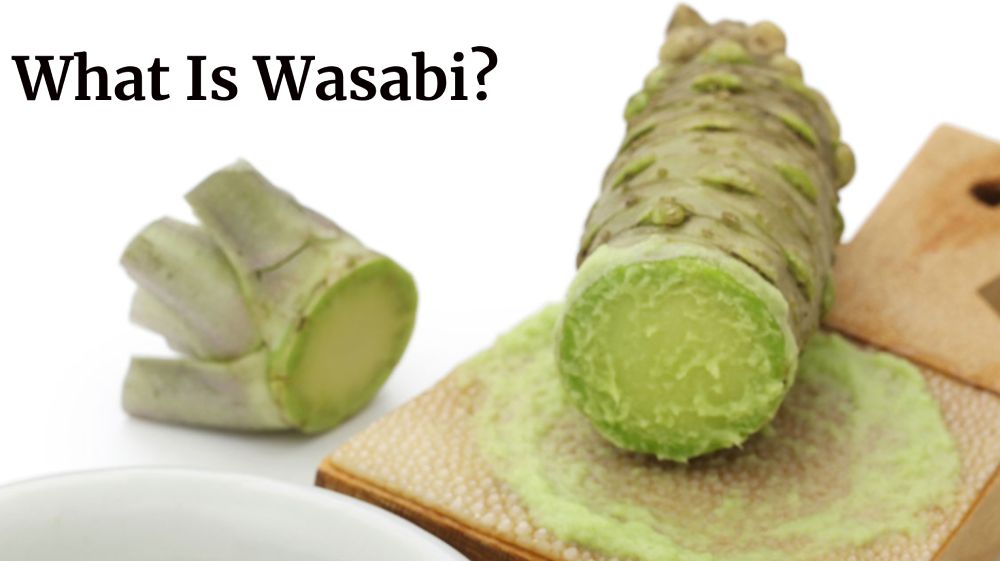You’ve come to the right place if you’ve ever wondered what’s in wasabi and why it’s so spicy.
You’re probably familiar with wasabi if you eat a lot of sushi and sashimi. The green paste on the side of your plate is wasabi, but what else is it? You may not know that this Japanese staple has an interesting history, and it’s one of our favorite food facts.
A native of Japan, wasabi has been used medicinally as an antibacterial since approximately 700 AD. As early as the 1100s, warriors began garnishing sashimi with the roots of the wasabi plant to add flavor or prevent bacteria. Despite not being completely clear to modern scholars, the warriors’ use of wasabi caught on.
That brings us to the wasabi you eat today…sort of. You’ve probably never even tasted real wasabi, since it’s so rare. Is there anything you’re eating right now? Here’s what you need to know. Once you’re up to speed, learn about umami, another flavor found in Asian cuisine.

Table of Contents
What is wasabi made of?
What exactly is wasabi? Wasabi is made from the ground rhizomes (aka the stems) of Brassicaceae mustard plants. Eutrema japonicum, the wasabi plant, is a native of Japan, though it has been grown in smaller quantities in China, Korea, and the United States. Due to its limited availability, rarity, and need to be imported, it is an expensive food. This is similar to why saffron is so expensive.
The interesting thing about real wasabi is that it loses its pungency once exposed to air. Since wasabi has more spice when grated right before serving, real wasabi is grated right before serving. In addition, it has a natural green color. On the other hand, imitation wasabi uses food coloring to achieve its verdant hue.
Why is wasabi so spicy?
It can be a tad spicy on the tongue if you’ve ever had wasabi…and that’s putting it mildly. Thioglucosides are responsible for this. It is said that thioglucosides are sugar glucose with sulfur-containing organic compounds. When you grind the stems of the wasabi plant, the cells break down, releasing the thioglucosides. It is for this reason that real wasabi is grated just before serving.
Wasabi’s kick is less heat and more sting, so people who like hot peppers don’t necessarily like wasabi. Although wasabi always has the same flavor (provided it’s real wasabi), its level of spice can vary depending on when it was prepared.
Wasabi that has been grated and prepared in advance will be less spicy than freshly grated wasabi because it loses its spice as soon as it hits the air. As a result, most wasabi sold in stores is fake—it’s easier to preserve the spice level when the plant isn’t involved.
What does wasabi taste like?
I find it hard to liken wasabi to anything else because it’s in a class of its own, but it tastes fresh and spicy. Wasabi is a member of the mustard family, so it’s similar to yellow mustard, although wasabi is spicier. You’ll actually feel the spice through your nose almost as much as you’ll feel it on your tongue. The flavor and spiciness are mostly released through fumes. The bite should travel through your nostrils and permeate your entire head when you eat it.
However, wasabi that isn’t true wasabi will taste more like horseradish, since that’s what it’s made from! With a little green coloring added, you get what you know as “wasabi.” Sriracha gets its extreme heat from a different plant.
What’s the right way to eat wasabi?
As mentioned earlier, wasabi complements the flavor of sushi and sashimi. Additionally, it can give your palate a little kick, while taming down the fishy flavor. According to Nobu chef and founder Nobuyuki Matsuhisa, dabbing a small amount directly onto your sushi and then lightly dipping it in soy sauce maximizes the flavor of your meal. It’s technically wrong to mix your wasabi with your soy sauce since it dilutes the flavor…but it’s up to your personal preference!
How can you tell real wasabi from fake wasabi?
If you pay attention to your wasabi’s appearance and preparation, you can tell the difference. The fake wasabi paste looks like, well, a paste. The texture of fresh wasabi is slightly looser because it is grated on the spot.
You probably haven’t eaten real wasabi due to how difficult it is to find it, and if you do, you’ll pay quite a bit for it. According to Business Insider, real wasabi costs around $250 per kilo (a little over two pounds). Although you might never need that much wasabi, it can be difficult to find it in smaller quantities, and if you do, you’ll likely end up paying upwards of $50 per rhizome. However, you can find fake wasabi products at your local grocery store for under $10.
According to Brian Oates, president of Pacific Coast Wasabi, approximately 99 percent of the wasabi served in restaurants in the United States is fake. Even in Japan, where wasabi grows, much of the wasabi served is fake! Although this stat is a little dated, the reasons why wasabi is so expensive remain the same.
Why is real wasabi so expensive?
The high price of wasabi is due to the limited availability of the mustard plant. It is expensive to produce wasabi in these regions and then transport it worldwide since these plants are only found in a handful of countries, primarily in Japan. The delicate nature of the plants is another factor to consider.
A cool, damp environment is necessary for their growth, and they can go bad quite easily. For plants to mature, they need to be given very specific, attentive care for about three years. As soon as the root is picked, it is grated or ground into the wasabi on your plate.
In specialized Asian markets that carry rare foods, wasabi may be sold as the root rather than in a container. Check the ingredients of the wasabi you’ve found in a grocery store if you’re unsure. Real wasabi contains only wasabi and nothing else, and it is usually sold as a powder or as the plant itself.
Horseradish and mustard are common ingredients in fake wasabi. While still remaining somewhat authentic, some products blend real and fake ingredients—wasabi with horseradish and mustard. It’s also easier to find wasabi sauce at the grocery store, which is a creamy wasabi-like condiment made from horseradish, oil, eggs, sugar, and corn starch; it’s often served with vegetables or noodles.
